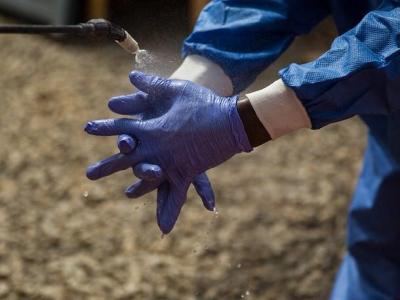(CIDRAP Business Source Osterholm Briefing) – I'd like to address a misconception that seems to be gathering traction. I'm sure it's one you, too, have encountered. People, including ones who sign your paycheck, are asking whether H1N1 was just another Y2K. You need an answer based on fact, not conjecture.
In short, both are situations in which (1) considerable money went into preparing for a looming threat, (2) severe disruption did not happen, and (3) opinions vary and discussions get heated about whether the threat was real or whether the work done to avert disaster actually paid off.
With the 2009 H1N1 pandemic, organizations that did spend time and money on pandemic preparedness can likely assign a dollar figure to their efforts. And organizations that did not prepare (which far outnumber those that did) would certainly like confirmation that the decision not to invest or not to make a decision at all was justified. In this period of economic upheaval, every dollar spent must be scrutinized. That's fair.
But using Y2K as the yardstick for comparison? Way off base. Let me explain why.
Y2K was a one-time event
The millennium "bug" was a single-point-in-time threat, the result of a computer programming anomaly created by the work of humans. Before the year 2000, the world had never experienced a Y2K meltdown. Fortunately, the world never did, and it never will.
The facts: Mother Nature rarely poses one-time threats. The toll of deaths and disease caused by four influenza pandemics in the past 90 years are indisputable. We can't simply change computer coding to avert the damage Mother Nature creates via influenza pandemics.
We knew the exact date for Y2K
The very nature of Y2K made the threat predictable—down to the second, in fact. Preparations had to have an end point. The Y2K preparedness race was to a finish line, not to some unknown date in the future, whether distant or close. By Jan 1, 2000, the preparedness resources were spent. End of story.
The facts: We know that pandemics happen. But we're far from knowing when the next one will occur. Sure, we can look at the period of time between the pandemics (periodicity) for which we have records. We can even average out those time periods, but why? Such a number predicts nothing. There's no pattern to be found in pandemic periodicity, no documented evidence of a minimum interpandemic period that can assure us we can let down our guard. Some 40 years separated the first two pandemics of the 20th century. People who counted on another 40-year break after the 1957 pandemic were caught short when 11 years later the next pandemic emerged.
But here's something we do know for certain: Influenza viruses are not predictable. They're even less predictable than fires, for which we invest heavily, knowing full well that the benefit in lives saved is unquestionably worth the price of preparing. I worry desperately that organizations will once again be lulled into thinking we've dodged a bullet and that we can relax for some 40+ years because that's how long we waited between the last pandemic of the 20th century and the first one of the 21st century.
Oh, and remember that novel influenza virus that just a few years ago launched billions of dollars of pandemic preparedness globally, prompted thousands of organization plans and hundreds upon hundreds of guidance documents, tabletops, and exercises? H5N1—it's still out there, as are any number of other influenza viruses that could cause the next pandemic. The fact that we've been through at least part of a novel H1N1 pandemic in no way precludes the emergence of another one tomorrow or years from now. What's more, we're only beginning to find ways to assess the real toll (ie, years of lives lost) and to compare pandemics in an "apples-to-apples" way, as I detailed in my Mar 26 and Dec 14 columns.
We knew in advance the 'bug' that posed the Y2K threat
Because the Y2K threat was a human creation, we knew precisely where to look for the problem—and how to fix it. It wasn't even a computer "virus" introduced by a malicious hacker. Preparing for Y2K did not involve the element of surprise.
The fact: We simply do not have the level of sophistication in our surveillance capacity to pinpoint the virus that will cause the next pandemic. Nor are we likely to acquire it any time soon. As we've seen with the H1N1 pandemic, the element of surprise is a given. Will the next pandemic cause unprecedented loss of years of productive life? Will it act like a mild seasonal influenza, or a terribly bad one? I wish I knew, and if I did, you'd be the first to learn of it.
Show me the data
Of late, likely in response to the Y2K question and as a way to defend their expenditures, I've heard of planners making the case that the resources and efforts their organizations committed in pandemic preparedness had something to do with why they averted serious business disruption. Some even cited lower absenteeism rates than non-pandemic flu seasons as evidence. In short, the claim is that their efforts had an impact on their organization. But before we can even begin such an assessment, we need to understand the larger picture of the pandemic's impact.
Make no mistake about it, as I've shared in the columns referenced above, the impact of the H1N1 pandemic was real and significant. It isn't evident when you look strictly at the number of deaths, but digging deeper into the numbers shows that this pandemic took the biggest toll on younger people (the ones likely to be in your workforce), whereas seasonal influenza tends to target the very old for deaths (over 90% of seasonal flu deaths are among people older than age 65). Using a metric of years of life lost (YLL), which more meaningfully shows the impact of deaths by age distribution, a team of government and academic researchers (of which I was a part) published findings that showed the impact of the current pandemic to be (1) much more significant than seasonal flu, (2) more akin to the pandemic of 1968-69, and (3) approaching the impact of the 1957 pandemic.
So where is the systematic, large-scale collection and reporting of data that can help us assess whether our preparedness efforts had any effect on the pandemic's the? What we have thus far is by and large anecdotal information, and that's not enough to make the case for anything. We haven't aggregated any solid data on absenteeism (be it from seasonal or pandemic influence), for example, or about the H1N1-related financial impact of such factors as:
- Services outsourced to developing countries, where access to antivirals, vaccine, and other life-saving medical services are not readily available, if at all
- School closures
- Lost-opportunity costs related to the chaos of the early days of the pandemic, especially when travel was restricted and employees had to stay home because they had traveled to areas with outbreaks
So, how can we at this point tease out the impact of our planning efforts from such variables as the nature of illness this pandemic caused, the availability and use of antiviral medications by people at high risk of developing complications or dying (eg, pregnant women), the access to earliest supplies of vaccine that certain groups had, or the use of life-saving equipment in intensive care units? While I think it's safe to say the H1N1 pandemic is waning and that we'll continue to see the virus circulate during our typical flu season, I also believe the story of this pandemic is still unfolding, offering data we need to capture and analyze.
A temptation to avoid—at all costs
I want to congratulate organizations that have taken the threat of an influenza pandemic seriously enough to make wise investments. Your efforts matter and will continue to be essential to how the world responds to this very real infectious disease threat.
But let me also offer a few words of caution. If you're willing to take credit for preparedness efforts lightening the impact of the pandemic on your organization, ask yourself if you're also willing to take the fall when things don't go so well. It's a classic case of "live by the sword, die by the sword." Don't let your credibility fall on the sword.
Bottom line for organizations
We must let the facts speak for themselves. No, H1N1 was not another Y2K. Frankly, it's quite the opposite. Do what you can to stop the misconception before it becomes an "urban legend." Avoid the very strong temptation to claim your preparedness efforts as a reason why your organization may not have experienced serious disruption to date. It's possible at some point you may be able to say that. But for now, collect all the data you need to make such a case. And remember that even when you think you're ready, your organization is part of a global picture for which not all parts have come into focus yet.



















